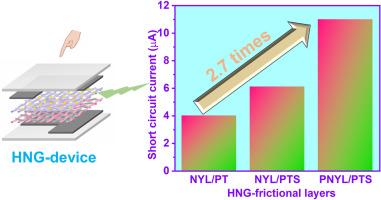工程纳米微纤维网络:尼龙11静电纺纤维上的聚苯胺纳米线在可穿戴生物力学传感中增强摩擦电性能
IF 8.2
2区 材料科学
Q1 MATERIALS SCIENCE, MULTIDISCIPLINARY
引用次数: 0
摘要
反复接触电气化引起的摩擦损耗是可持续能源收集领域的重要研究挑战。在使用传统绝缘体之后,改善这一问题的一个有希望的方法是将电荷捕获、电子捕获和导电填料结合到聚合物基体中。在这项研究中,我们开发了一种先进的混合纳米发电机,包括用聚苯胺纳米线(PNYL)和钛酸锶(SrTiO3)负载的聚偏氟乙烯-三氟乙烯(P(VDF-TrFE))层(PTS)修饰的尼龙-11电纺丝层。采用静电纺丝法制备了尼龙-11膜,并通过稀化学聚合对尼龙-11膜进行了聚苯胺改性。聚苯胺NWs由于其-NH2基团增强了尼龙-11的摩擦正极性,同时通过其导电性减少了摩擦电损失。同时,电荷捕获P(VDF-TrFE)和介电SrTiO3填料提高了摩擦负层的性能。优化后的PNYL/PTS-HNG具有较高的电输出,开路电压(VOC)为195 V,短路电流(ISC)为11 μA,比纯NYL/PT-HNG分别提高了387%和175%。此外,它还具有66.7%的机械能转换效率和优异的机械灵敏度(~ 58.4±6.6 V kPa−1)。这些发现突出了PNYL/PTS-HNG作为高性能、自供电的可穿戴生物力学监测传感器的潜力。本文章由计算机程序翻译,如有差异,请以英文原文为准。

Engineered nano-micro fiber networks: PANI nanowires on electrospun Nylon 11 fibers for enhanced triboelectric performance in wearable biomechanical sensing
Triboelectric loss due to repeated contact electrification remains a significant research challenge in sustainable energy harvesting. A promising approach to improving this issue following the use of conventional insulators is the incorporation of charge trapping, electron trapping, and conductive fillers into polymer matrices. In this study, we developed an advanced hybrid nanogenerator comprising electrospun layers of Nylon-11 modified with polyaniline nanowires (PNYL) and strontium titanate (SrTiO3)-loaded poly(vinylidene fluoride-trifluoroethylene) (P(VDF-TrFE)) layers (PTS). Nylon-11 membranes were fabricated via electrospinning and modified with PANI NW via dilute chemical polymerization. The PANI NWs enhance the tribo-positive polarity of Nylon-11 due to their -NH2 groups while reducing triboelectric loss through their conductivity. Meanwhile, the charge-trapping P(VDF-TrFE) and dielectric SrTiO3 filler improve the performance of the tribo-negative layer. The optimized PNYL/PTS-HNG achieves high electrical output with an open-circuit voltage (VOC) of 195 V and short-circuit current (ISC) of 11 μA, indicating 387 % and 175 % increases over pure NYL/PT-HNG. In addition, it exhibits a mechanical energy conversion efficiency of 66.7 % and excellent mechano-sensitivity (∼58.4 ± 6.6 V kPa−1). These findings highlight the potential of PNYL/PTS-HNG as a high-performance, self-powered wearable sensor for biomechanical monitoring.
求助全文
通过发布文献求助,成功后即可免费获取论文全文。
去求助
来源期刊

Materials Today Nano
Multiple-
CiteScore
11.30
自引率
3.90%
发文量
130
审稿时长
31 days
期刊介绍:
Materials Today Nano is a multidisciplinary journal dedicated to nanoscience and nanotechnology. The journal aims to showcase the latest advances in nanoscience and provide a platform for discussing new concepts and applications. With rigorous peer review, rapid decisions, and high visibility, Materials Today Nano offers authors the opportunity to publish comprehensive articles, short communications, and reviews on a wide range of topics in nanoscience. The editors welcome comprehensive articles, short communications and reviews on topics including but not limited to:
Nanoscale synthesis and assembly
Nanoscale characterization
Nanoscale fabrication
Nanoelectronics and molecular electronics
Nanomedicine
Nanomechanics
Nanosensors
Nanophotonics
Nanocomposites
 求助内容:
求助内容: 应助结果提醒方式:
应助结果提醒方式:


